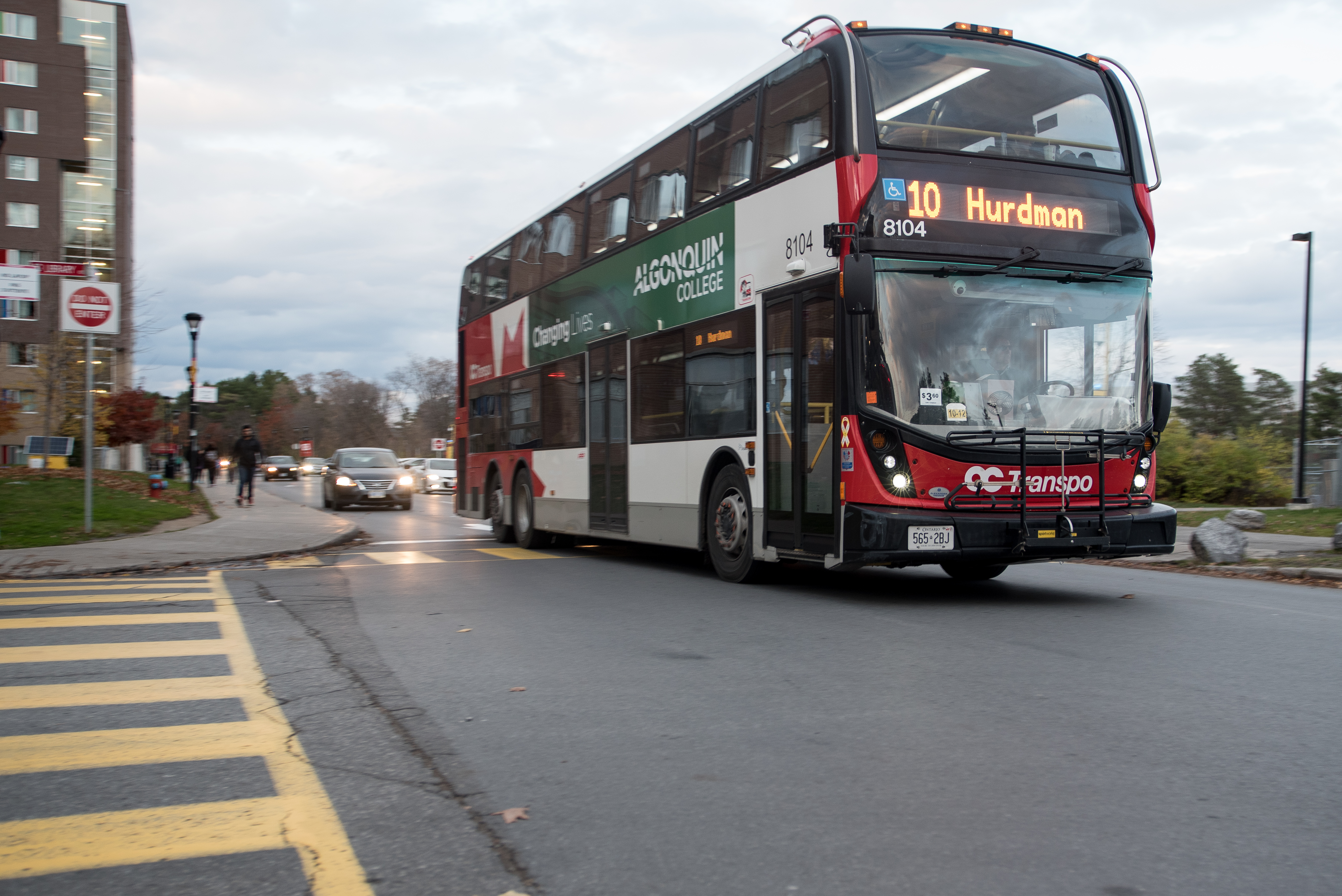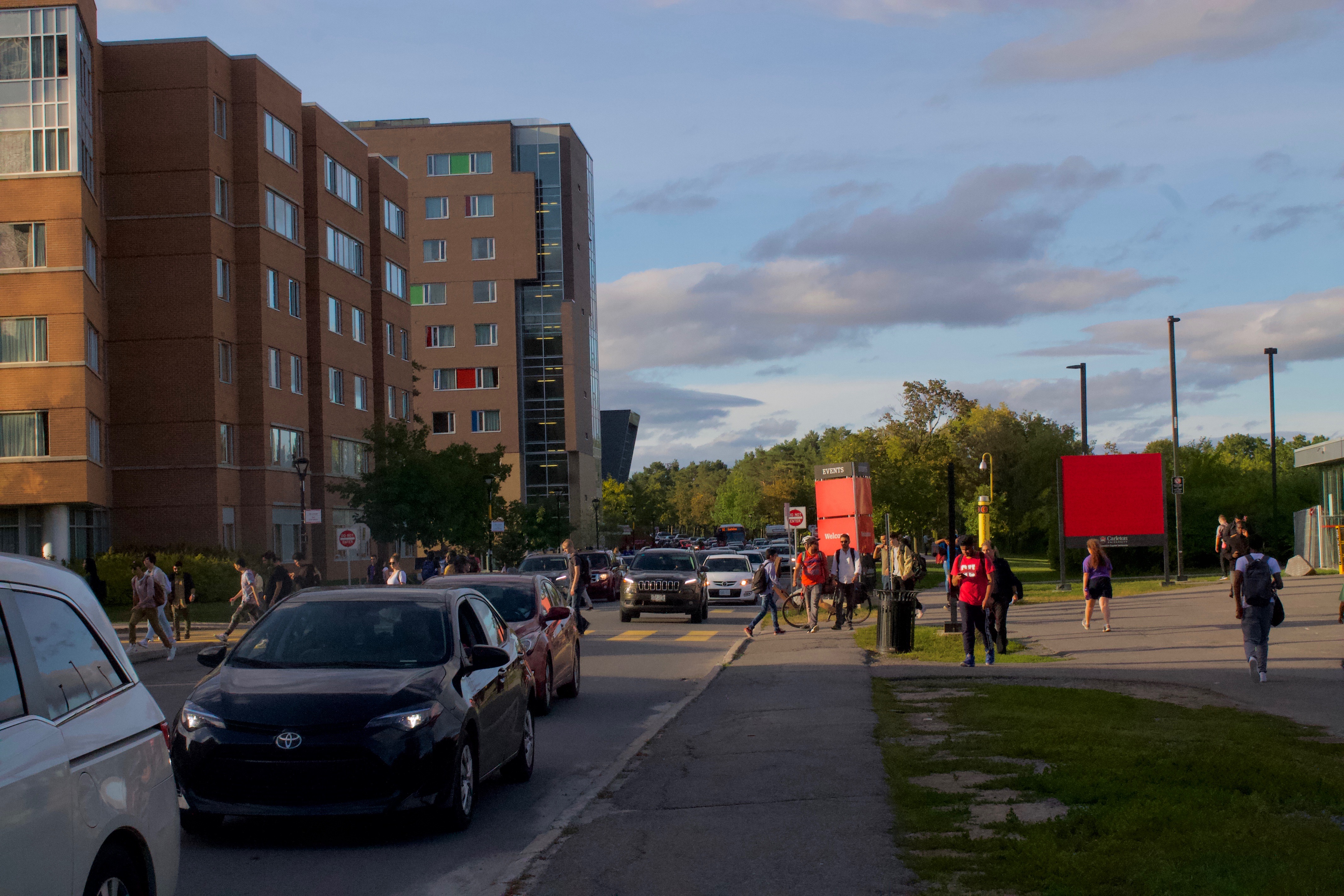You’re in a hurry and you decide to bite the bullet. You spare those extra dollars to order an Uber or Lyft instead of walking or using OC Transpo, because it’ll take too long.
But as you rush to leave campus, you realize you’re having the same conversation you’ve had every time you tried to exit the university this fall.
It’s a conversation anyone driving a car, getting on a bus, or a train, and even those walking with a friend out of campus have had since September: Carleton’s changes to transportation.
“It almost as if once you’re on campus, you really can’t get out,” says second-year law student James Carrion, chuckling with frustration. “Carleton looked like a completely different school the moment I walked on campus after the summer.”
Carrion’s not the only one who thinks this way. Multiple students, faculty, staff and members of the Carleton community have told the Charlatan they’re frustrated with changes made to campus transportation.
But according to university administration, it doesn’t seem like these changes—like the one-way conversion of Campus Ave.—are going away anytime soon.
The university’s transit and transportation infrastructure will look starkly different in the next three years, said several senior Carleton staff members in interviews.
In fact, some bigger proposed changes are only now getting started, according to a 90-page report prepared for the university by consultation firm Parsons, obtained by the Charlatan. And they will affect members of the community using all modes of transportation—on wheels, on rail, or on foot.
Several of these changes though will not be completed in time, admitted sources responsible for campus planning and facility management. And according to them, it’s mostly the City of Ottawa to blame.
On wheels
Bordered by the Rideau River and Rideau Canal, Carleton consists of three main roads. The Library Road, running along the canal on one end, serves as the exit and entrance to an 8.1-km Colonel By Dr., one of Ottawa’s largest and busiest roads. University Dr. on the other end of campus acts as the entrance and exit to Bronson Ave., a busy, six-lane city road with incoming traffic from downtown Ottawa.
Pearled between two of the roads is Campus Ave., which houses Carleton’s residence areas and most major campus buildings.
 That’s why when the university converted Campus Ave. into a one-way road, it effectively gridlocked traffic exiting towards Bronson Ave.
That’s why when the university converted Campus Ave. into a one-way road, it effectively gridlocked traffic exiting towards Bronson Ave.
Uber driver Didier Faraja remembers when he could drop off around 20 customers to Carleton within an hour, just last year.
“Since this bullshit one-way stuff, I’ve literally been stuck on campus after drop-offs for hours on end,” says the 27-year-old, whose primary source of income has been Ubering students from Carleton-neighbouring areas, such as the Glebe and Centretown, since early 2018.
Faraja says he’s had to cancel several Uber rides because it’ll cut down on his working hours if he’s stuck in Carleton for too long. “It’s honestly heartbreaking though,” he says, “telling students who’re late for class, ‘no, I can’t drop you off.’”
Several other commuters, who aren’t Uber drivers like Faraja, told the Charlatan they share his frustration.
“I literally dread getting out of campus once I’ve finished classes,” says fourth-year health science student Amy Valez, who drives every other day of the week to Carleton. “I thought it’d get better once people settled in, but it’s really just frustrating because it hasn’t at all.”
But the one-way system is a way to combat previously-existing traffic, not increase it the way it happened, according to the university.
“The lights on Bronson Ave. couldn’t handle the traffic it used to get, which existed even before there was a one-way system,” said Christopher Moy, assistant director of Campus Safety. “The traffic right now is mostly because people aren’t used to the one-way system yet.”
The university’s plan “has always been” to get a roundabout at the intersection of the Bronson Ave. entrance leading to Campus Ave. and from University Dr., said Moy.
Asked by the Charlatan when the roundabout will be built, Moy said a fixed date or timeline for that doesn’t exist.
“It’s a matter of letting people know that there are other exits that exist, where they can get out of campus from,” he said. “To that end, we’ve been trying to place signs and educate people where ever we can so they’re made aware.”
It’s not just cars that are affected by the one-way conversion. Since buses have not been provided designated lanes on Campus Ave., they have also faced severe delays, especially during rush hour.

However, there is no exact deadline for when construction work will finish on that expansion, said Brian Dawod of Morrison Hershfield, the firm hired by the city for the project.
“We’re hoping to have it done by the 2020 school year, but we really don’t know if it will be,” said Dawod. “And if it isn’t, we’ll have to clear out the parking lot near there for worker crews to continue on construction through the school year.”
Local city councillor Shawn Menard says “more buses need to be running to and from Carleton anyway, even without any of the congestion caused by the one-way system at the university.”
“But after talking to students at Carleton, I’ve realized it would’ve been much easier had it not been changed in that way,” said the Capital ward councillor in an interview. “Perhaps they should’ve at least had designated lanes for buses.”
On rail
Starting next summer, the O-Train Trillium line will be closed until September 2022—a year longer than previously planned.
The city is promising that during the Stage 2 LRT expansion more buses would run to and from Carleton, including routes otherwise covered by the O-Train.
 But given the lack of a deadline for the Raven Rd. expansion—a key feature in maintaining traffic created by newer bus routes during the train line shutdown—several Carleton students expressed frustration to the Charlatan.
But given the lack of a deadline for the Raven Rd. expansion—a key feature in maintaining traffic created by newer bus routes during the train line shutdown—several Carleton students expressed frustration to the Charlatan.
“I’m not entirely sure I actually trust that there will be more buses,” said Mohsin Anniq, a third-year engineering student. “Looking at OC Transpo’s history, you know, it’s not wrong to assume that they won’t actually do as they’re claiming.”
Moy says all Carleton can really do is wait and see if the city fulfils its promises.
“At the end of the day, we don’t really have much control over the city’s timelines, and their timelines change all the time,” he said. “There’s lots of reasons for that—politics, potential strikes and whatnot.”
“What we can do in the interim is letting people know about all of these changes and prepare solutions that we can implement from our end.”
Some of these solutions include creating more ride-sharing zones, educating people about alternatives, and “maintaining a healthy dialogue with the city to express what we’d like to see,” explained Mansfield.
“But it’s confusing when we have our own plans within the university setting to tell people to use more transit, and we’re actually having the most effective transit eliminated for so long.” — Philip Mansfield, facilities manager at Carleton.
“We obviously want to see more people at Carleton walking, biking and not driving, and that’s showcased in our future plans,” he added, referring to the Parsons report, which dedicates several sections to making Carleton more “pedestrian-friendly” within the next five years.
On foot
Pedestrians and cyclists at Carleton can also expect several changes over the next few years, according to the Parsons report.
Some of these changes will include safe bike routes on campus, compounds for storage, and shower facilities for people cycling to campus, explains Mansfield.
“The idea really is to make sure we don’t rely as much on people using cars to come onto campus,” he said. “We want our campus to be a lot more sustainable.”
But Moy says the city will need to meet their deadlines for any of these plans to actually work.
“When the trains shut down, it sort of has this domino effect for all these other changes we have planned. It’s a mountain we all have to climb because if it doesn’t finish in two years, our other plans don’t necessarily work.” — Christopher Moy, assistant director of Campus Safety.
“We’ve done a lot to present infrastructure that’s sustainable in the long-term here at Carleton, which someone looking at the university in five years would say makes it seem like a completely different campus,” says Mansfield.
“To make that happen though, everyone—the city, the university and the community members—all need to come together in seeing their responsibilities all come through.”
Featured image by Saraah Rasheed.






